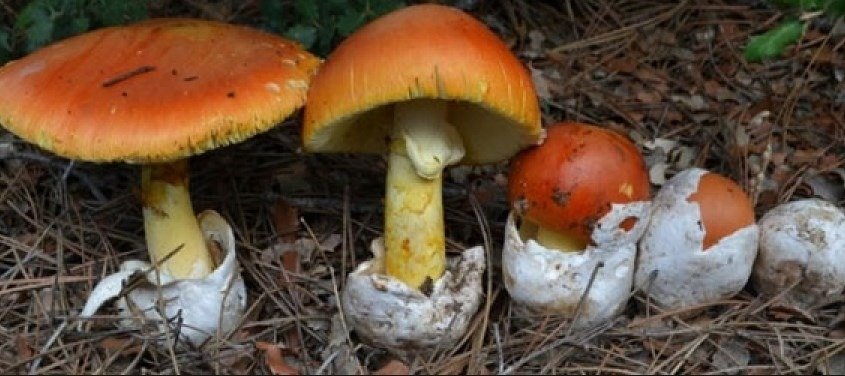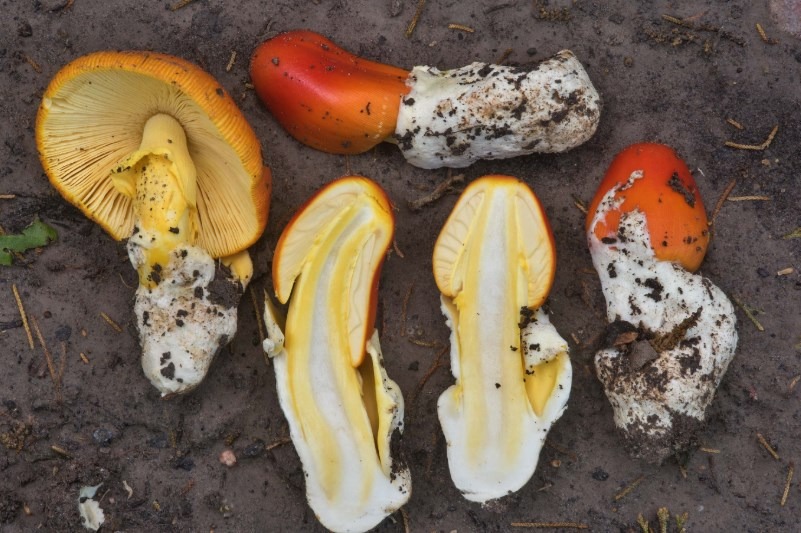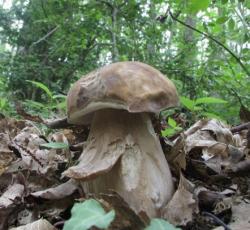The Amanita Caesarea is one of the best and most famous mushrooms that can be found in our territories. The name comes from the Latin word “Caesareus” which means “of the Caesars“.
In fact, the ovoli mushrooms (this is how this type of amanite is called in Italy) once adult, are also called the “mushroom of kings and emperors” because appreciated by Roman emperors (Caesar was not an emperor) for their deliciousness.
Be careful, however, because in the young stadium can also be confused with other amanite at the early stage because all similar to a small egg.

Indice
Other names of Amanita Caesarea
The amanita Cesarea in Italy is also known by many other names. It is also commonly called good egg, royal mushroom, egg, red mushroom. The most famous name is Caesar’s Mushroom.
Description of Caesar’s Mushroom.
Like other amanites, the good Caesar’s mushrooms, in the first stage of development, are wrapped by a membrane which is even 2 mm thick. The veil is fleshy and consistent and assumes the characteristic egg shape.
It is very important to underline this fact: only at this very early stage of development can the amanita caesarea can be confused with the deadly Amanita Phalloides, which also has a white egg shape.
The Cap
Once the mushroom begins to develop, the cap of the Amanita Caesaria begins to grow out of the white membrane that splits. It measures from 6 to 20 cm in diameter and at the beginning it has a hemispherical shape which then becomes flat and stretched out in the adult specimens.
The appearance is robust, smooth and brilliant. In wet weather, the cap looks viscous and not too rarely there are white fragments of the veil that stick to the cap and contrast with its bright orange.
The color is yellow orange or red orange with the typical warm shades. The colour of the cap of the
Amanita Caesaria mushrooms in question is sometimes variable and can range from orange with shades of red to more or less light yellow. The flesh under the cap is yellow.
Gills
The gills are thick and quite wide. Their colour is egg yellow and they are also intercalated by lamellulas.
Stipe
The stem measures from 8 to 18 cm in height and is 2 to a maximum of 4 cm thick. Then, the shape is cylindrical and at the base there is an enlargement because the base is wrapped in the leathery vulva. The colour of the stem is always egg yellow with lighter shades in the upper part of the stem.
Ring
The membranous ring is present and is very showy in the upper part of the stem. The colour is the same of the stem and falls down like a festoon.
Flesh
The flesh of the Amanita Caesarea is compact and tender in the hat. In the stem, on the other hand, the meat is more consistent. The colour is white and the taste and smell are very pleasant. This is until the fungus becomes mature, at that time it gives off a disgusting smell of rotten eggs.

Habitat and diffusion of Amanita Caesarea
The Caesar’s Mushroom prefers open areas with acidic soils such as chestnut and oak forests. In Italy it is widespread mainly in the centre and in the south, being a typically thermophilic species. In the north of Italy, however, there are some microclimates that are favourable to its development.
As already mentioned, it is a mushroom typical of chestnut groves but also of the Holm oak core woods and other types of Oaks. In general, being a symbiotic fungus, it coexists with the various broad-leaved trees (up to the exception of the Silvestre Pine). In order to grow, this fungus prefers the more open areas of the wood, for example those worked by woodcutters the previous year.
Period of Growth
The Amanita Caesarea grows from early summer until early October, usually. It is usually a species stormed by mushroom gatherers because of its delicacy, so finding it is not as easy as it may seem, even if the fungus is widespread. From here it can be deduced that the price of good harvested eggs can also be quite high.
As already said before, the amanita Caesarea can be confused with the Amanita muscaria which is poisonous. It can be also confused with the Russula aurata because it has a similar colour of the gills and of the cap. Also the Amanita crocea and the Amanita aureola are confusable with Caesar’s Mushroom.

Amanita Caesarea Recipes
The amanita Caesarea is one of the most sought after mushrooms in gastronomy. It is said that the amanite family contains the most deadly fungus and the best fungus at the same time. It is known for certain that the Amanita Caesarea was already appreciated in Roman times for its tasty and delicate meats.
Dried Caesar’s Mushrooms
Caesar’s mushrooms can be eaten in many different ways, whether raw, cooked or dried. If we dry the Amanita Caesarea we can only use it at most to color some yellow sauce.
Raw Amanita Caesarea
Served raw, on the other hand, the egg has now become a classic dish of the kitchen. They can also be preserved in oil.
A simple and quick recipe could be to prepare some slices of homemade bread, perfume them with garlic and a little olive oil. Once this is done, place a thin slice of mozzarella on top of each slice of bread. On top of the mozzarella, put a slice of Amanita Caesarea made before macerating for 2 hours in the oil, lemon, salt, pepper and a few pieces of chives or parsley.
In general it is advisable to eat the amanita caesaria raw especially the younger specimens. However, the older ones are also very good grilled I served as a condiment for fresh pasta.
Obviously, before cooking the amanita caesaria mushrooms, it is necessary to clean them well and check the stem, which often has larvae, especially at the base, which must then be cut off and discarded.
IDENTITY CARD
CAP COLOR: Orange
STIPE HEIGHT: 8-15 cm
STIPE COLOR: yellow
GILLS: yellow
FLESH: White
SMELL:light
TASTE:light
SPORE: white
HABITAT: Hardwoods
Did you find what you were looking for? See also here:
- Ganoderma Lucidum
- Armillaria Mellea
- Amanita Caesarea
- Agaricus Bisporus
- Amanita Phalloides
- Coriolus Versicolor
- Flammulin Velutipes
- Marasmius Oreades
- Pleurotus Ostreatus
- Agaricus Campestris
- Macrolepiota procera
